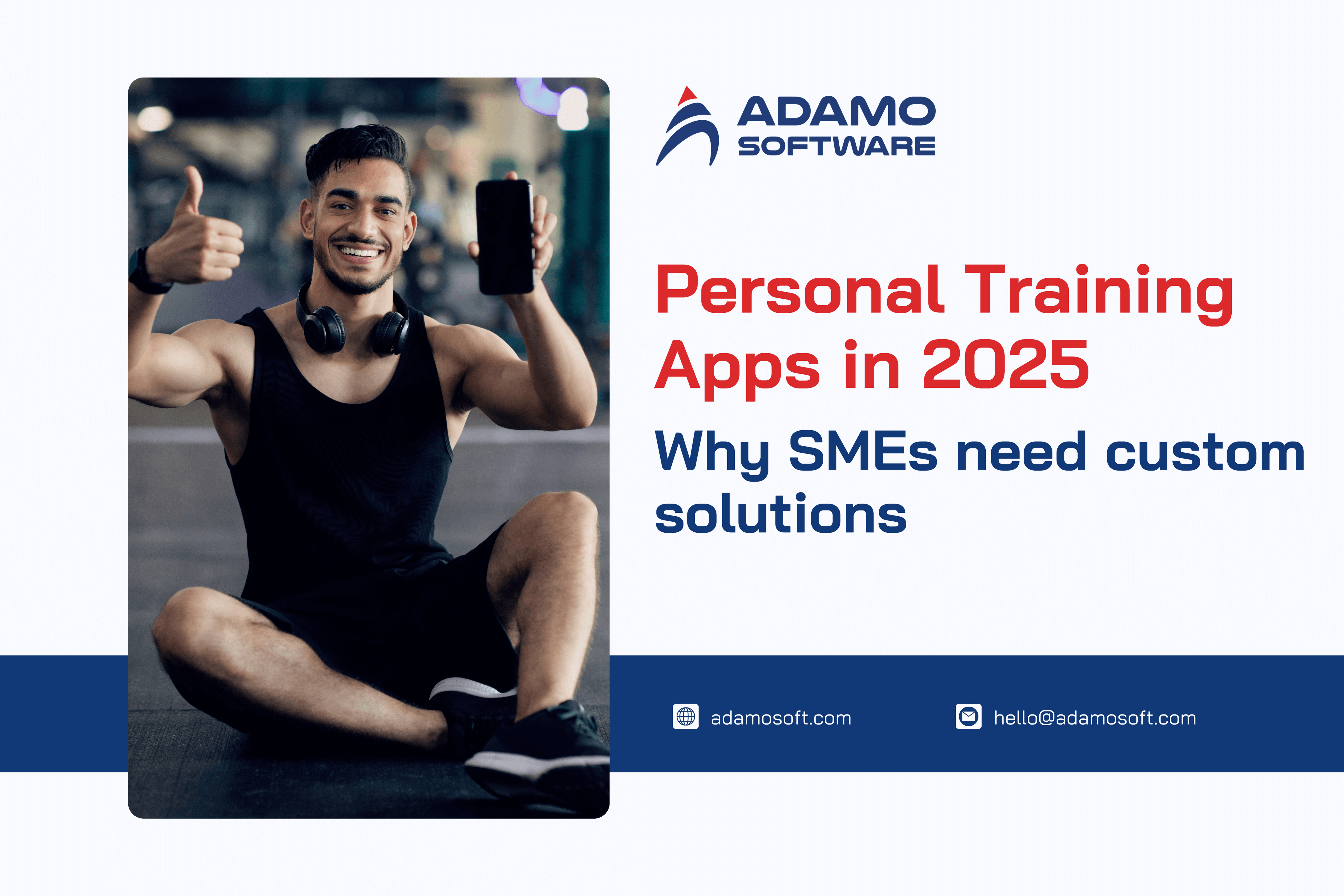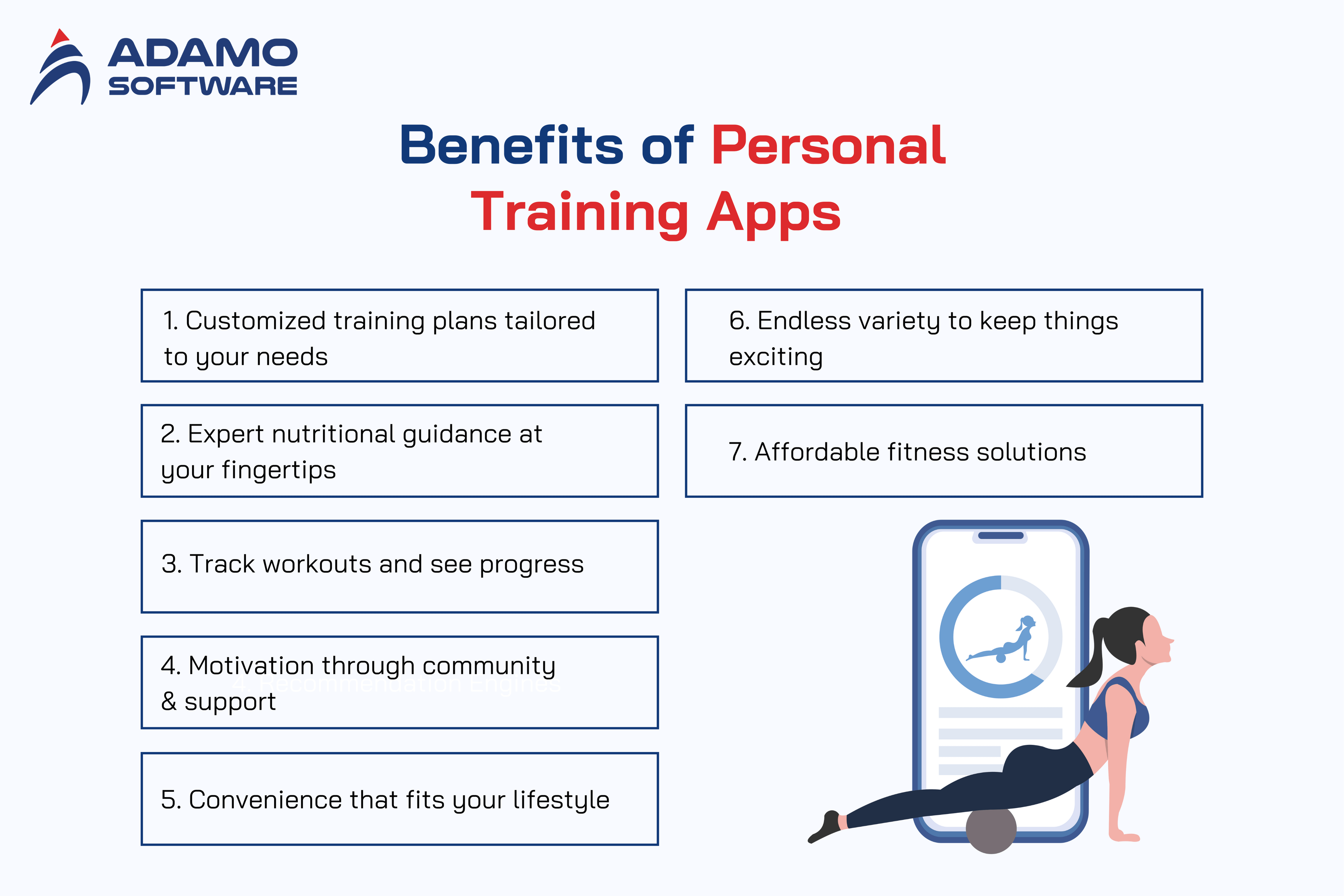Personal Training Apps in 2025: Why SMEs need custom solutions

Watch out – ready-made apps are holding you back! Discover why SMEs need custom personal training apps in 2025.
In 2025, personal training apps will transform the fitness industry, providing SMEs with tailored solutions for better client engagement and efficient operations. Virtuagym and Trainerize, for instance, provide solutions that enable organizations to customize their fitness services according to client needs for personalized experiences.
Digital fitness solutions have gained popularity because consumers need flexible and convenient fitness solutions. The expanding fitness market compels SMEs to adopt custom personal training applications for business success.
Combining improved consumer satisfaction with behavioral data collection allows businesses to enhance their strategy development. Custom personal training apps enable SMEs to distinguish their services from competitors to achieve lasting business expansion. This decisive strategy proves fundamental for companies who want to succeed in the modern fitness industry.
In this blog, we’ll dig deeper into why it is important for SMEs to make good use of custom personal training apps.
I. The rise of personal training apps for SMEs
Health and wellness platforms now emerge from the basic functionality of step counters and exercise logs in personal training applications. People have made sharing their exercise achievements online an everyday practice.
The fitness tracking feature of Apple Fitness provides a popular service to users of Apple Watch and iPhone devices. This system shows three areas of movement tracking, which log active calorie usage, workout duration, and time spent standing. The major device company Fitbit also uses sensors to track step counts, distance traveled, and heart rate levels. The current market offers many fitness tracking applications to maintain ease of access to users.
These days, personal training applications prioritize user convenience through built-in tools that help users track their physical activity results. Whether these apps lead users toward sustainable activity or exist solely as a health trend remains a question for many.
Unmatched market growth in fitness apps
The revenue of fitness applications reached $3.58 billion in 2023, showing their extensive growth. The COVID-19 pandemic directly affected how the fitness industry evolved. The fitness application market before the pandemic amounted to $2.87 billion in 2019. Revenue increased drastically by 46% throughout the initial six months of the pandemic in 2020.
The number of fitness applications downloads rose significantly by 350% starting from March 2020. The global fitness app market is expected to expand to $14.7 billion in 2027. This represents a projected yearly growth rate of 21.6% from 2020 to 2027.
Personal training apps focusing on weight loss and diets make up 55% of all fitness app business. Apple Fitness controls 29% of the market, whereas Leap Fitness Group apps maintain 22% of the market share.
Personal training app downloads are skyrocketing.
During 2023, fitness applications received more than 850 million downloads. The worldwide rise in fitness application downloads increased by 46% throughout the pandemic. The number of new active users in India experienced a shocking increase of 156%.
The pandemic essentially triggered a permanent change in personal health management where users strongly embrace personal training apps for their wellness needs.
The rapid increase in app usage
The number of fitness app users expanded to 368 million in 2023, surpassing pre-pandemic levels by 55%. People commonly utilize downloaded fitness apps on a daily basis and not just only download them.
The global number of people using fitness apps daily rose by 24% during the pandemic. Personal training apps have turned into essential elements of user routines rather than remaining as mere downloaded apps.
Fighting non-communicable diseases (NCDs) with fitness apps
Poor nutrition and lack of exercise contribute to serious health issues like high blood pressure, elevated blood sugar, and obesity. The physical risk factors develop as metabolic indicators that boost the danger of cardiovascular disease. This heart-related condition is the main cause of premature death from non-communicable diseases.
Each year, 830,000 deaths occur because people do not exercise enough, according to the World Health Organization. The impact of these diseases may decrease with the help of personal training apps, which promote better lifestyles.
II. Benefits of Personal Training Apps

1. Customized training plans tailored to your needs
Personal training applications deliver their most important advantage through fitness programs developed specifically for each user. Users of this system can provide details about their fitness targets while specifying which exercises they like alongside any existing medical issues. The application then uses user information to generate workout plans focusing on individual requirements. Personalized workout plans that exceed traditional gym programming represent a feature that these apps deliver better than standard generic plans.
The personal training application gives users complete access to their workout plans anywhere they use it. Maintaining fitness goals will remain simple for people who travel or handle heavy workloads. The application also allows users to execute their custom-designed plan no matter their location while guaranteeing adherence to the program.
2. Expert nutritional guidance at your fingertips
One main benefit of many personal training apps is their ability to offer users nutritional guidance. The apps provide users with meal planning functions, including calorie tracking and dietary tips designed to assist in better food selection. Users can monitor their food consumption for recommendations matching their nutritional requirements to receive the nutrients necessary for their fitness goal progress.
3. Track workouts and see progress
Fitness tracking features and progress monitoring capabilities define the excellence of personal training applications. The system allows users to register workouts while showing them their performance development and offering performance assessment feedback. As a result, user engagement increases as tracking capabilities simultaneously provide critical feedback, helping users modify their workout strategies.
4. Motivation through community and support
Another benefit is that the features implemented by personal training apps aim to boost user motivation. Users can exchange support with others on social platforms found within these apps who share their fitness objectives. Users gain from this social aspect by sharing their achievements and receiving support and advice from others based on their experiences.
5. Convenience that fits your lifestyle
Personal training apps offer their users complete flexibility. Users can achieve workouts whenever possible because these apps free people from fixed gym schedules. Through workout plans, nutritional tips, and progress tracking access, users maintain better fitness results because they can use the platform conveniently.
6. Endless variety to keep things exciting
Personal training apps keep users away from boredom by presenting diverse workout options to them. Users can access various exercise types, from strength training and cardiovascular to yoga and on-demand workout sessions, to maintain workout variety. Through live session offerings in addition to their workout options, these apps create interactive exercises that are fun to do during workouts.
7. Affordable fitness solutions
The online training solution functions as a cheaper option than standard gyms. The solution gives users on-demand custom workout plans, dietary information, and performance monitoring tools for affordable prices.
For instance, The Apple Watch compatibility feature integrated into numerous personal training apps lets users check their fitness goals easily. The business tools listed by ABC Trainerize act as game-changers for company owners who seek to optimize their operations and benefits.
Read more: Best apps for personal trainers: Top 15 +reviewed by coaches
III. Why Off-the-Shelf Personal Training Apps Fall Short
Custom personal training apps are now preferred over off-the-shelf options due to their superior customization for individual user needs. Custom-made apps provide better solutions than ready-made apps because they create features that serve distinct fitness goals. They also support individual preferences with the capacity to adjust to changing demands.
These key advantages of custom personal training apps are why they have become a favorite choice of businesses over the years:
1. Maximize your efficiency
The custom personal training application reduces companies’ total work hours through its ability to handle preloaded video content, nutrition plans, and other resources. The content organization enables fast and convenient sharing with all clients, either for one-on-one training sessions or group exercise classes. When you can handle your entire workflow efficiently with a single application, it stores all client data, performance metrics, and scheduling details. This makes them easily accessible through a few simple clicks.
2. Deliver a truly personalized experience
Custom personal training app provides a superior capability to customize the client experience beyond standard offerings. The customized application adds value by offering personalized programs each client perceives specifically designed for them. The application delivers customized workout plans and constant support while offering additional encouragement to make clients feel valued while undergoing their fitness transformation.
3. Build a standout brand
Any fitness brand would need customized personal training software to demonstrate professional competence in the industry. Your brand credibility increases thanks to the app, which gives your clients lasting memory retention of your name. Your smart app presentation through branding results in increased client trust that profits in improved sales and fortified client loyalty.
4. Stay ahead of the competition
To succeed in such markets, you must develop a remarkable brand presence. Implementing custom personal training applications gives trainers an exclusive market position. Few trainers have embraced this technology, which helps position you as an innovative practice that caters directly to customers. Your unique status enables you to draw new clients and keep them while other trainers fail to compete effectively.
5. Connect easily with your ideal clients
Identifying your target market involves more than recognizing their characteristics because you need to deliver services in their preferred environments. Your custom personal training app functions perfectly in app stores, so anyone with a smartphone or tablet can easily access it. Social media promotion combined with this solution ensures a successful connection with your intended audience, leading to expanding your customer base.
IV. Key features of custom personal training apps
The essential elements that an application for personal training offers directly determine its success. For differentiation, you must include new modern features that follow present market standards and user demands. Providing modern user-focused features will make your fitness app competitive while offering exceptional experience to users in this marketplace.

1. Simplified goal setting and onboarding
Users must be able to establish fitness targets and objectives immediately after their personal training app is installed. The system should guide new users to set up their accounts by asking about their fitness interests, health status, and workout objectives. This personalized system creates an easy start that provides individualized service at every step from the beginning.
2. Personalized workout plans with AI integration
Custom workout programs are essential. Your application should harness AI and machine learning to analyze user fitness data and develop individual plans that adjust to users’ progress. The dynamic approach lets users stay interested in their workouts since the exercises match their current achievements.
3. High-quality exercise videos and audio guides
The platform should provide built-in video recordings and audio instructions that show users proper exercise movements. The content may include real-time graphics and YouTube links, which are diverse user options. Visual details protect users from injuries by showing correct postures and helping them maintain proper form during workouts, thus keeping their workout enthusiasm.
4. Adaptive workout timers
System timers must adapt to suit user fitness abilities and their workout advancement status. Beginners should have longer workout durations than experienced users, who can benefit from shorter high-intensity periods. The system should also allow users to personalize their training routines, improving their training outcomes.
5. Advanced calorie tracking
People who practice physical fitness must pay strict attention to their calorie consumption. Users should have access to tools showing their food calorie intake and consumption during eating and exercise sessions. A complete nutritional and activity information breakdown enables users to make informed health decisions.
6. Meal planning and hydration tracking
The application should feature individual-targeted meal-planning resources for users to track their meal choices. Users can track their water consumption while receiving notification prompts to prevent dehydration. Such capabilities support users in maintaining essential balance when pursuing fitness goals and health maintenance.
7. Online fitness consultations
Users should have access to private consultations conducted by trainers and fitness experts. Develop collaborations with specialists who can offer tailored suggestions for individual customers. This specific feature will attract many fitness enthusiasts who need assistance with their exercise journey.
8. Voice-control technology
Users need higher convenience from the app via voice-command features. Users should be able to manage timers, view routines, and monitor their progress through voice commands. The modern addition improves accessibility and creates an uninterrupted app experience for users.
9. Leaderboards for motivation and competition
Adding leaderboards will motivate users because they can compete with others in a friendly manner. Users can view their worldwide positions and create friendly competitions with their contacts. Users will then become more engaged as their continued application usage increases through achievement displays.
V. How SMEs can build a Personal Training App that stands out
SMEs, along with other businesses, face substantial challenges in developing their own custom personal training applications. As usual, a successful app development process follows certain essential steps to simplify the creation path:
Conduct market and competitor research
Research into the market and competitors is vital as it benefits all business sizes. Why? Well, first of all, industry research helps identify necessary features and trending topics to meet user requirements.
The analysis of competitors must be conducted simultaneously because it uncovers which personal training application leaders are performing best. This stage is when you expose users to the core features, technical aspects, sales methods, and promotional tactics of top apps in the market. Understanding this information should help you adjust your app’s strategy to increase competition.
To establish robustness, consider working with businesses that provide market analytical services. Develop surveys either on your own or through partners to discover answers regarding the following aspects:
- Who your target audience is
- What challenges they face
- How your app helps tackle the challenges that they’re facing
- What features they value the most
Your application purpose will become clear when you answer these questions, which will establish a concrete development plan.
Choose the right features and tech stack
Select features and technologies that match your app requirements after completing research activities. Use the examined features while drawing from competitor information to discover popular features.
The selection of appropriate technological tools stands similarly vital in the process. For instance, a personal training application’s front end would require tools like JavaScript, Angular.js, HTML5, etc. For the back end, you may need to use Ruby, Phoenix, or Python. Similarly, for databases, you should consider Redis, MySQL, and MongoDB. Other factors like cloud storage, utilities, payment gateway, or programming languages should also utilize the most suitable tools.
Consult with tech experts to validate your choices and ensure your app is built on a strong foundation.
Ready to Outsource?
Get top-tier IT talent without the hassle. Contact us now!
Start with an MVP
Developing minimum viable products (MVPs) represents a budget-friendly method of building applications. The development of an MVP helps you check essential features with incomplete application development to gather practical data about their performance.
Teamwork between designers and developers enables you to develop a prototype model for your personal training application. The prototype will demonstrate exactly what your selected features will look like and operate as people use them in real-life situations.
When using an MVP, you gain data to identify the essential features and those that need improvement and unessential elements. New development methods implemented through this process can reduce the overall expenses of testing and development periods. By following this approach, you will get a precise understanding of the final product and receive a professional application that meets audience needs.
Collaborate with an experienced development company
A fitness app development project requires a professional personal training app development company to achieve successful app creation. The expertise of these companies will help your application embrace new industry standards and emerging technologies to excel in the market.
One advantage of using these firms is their capability to provide professional developers whenever needed. Such companies provide flexible pricing structures and adaptable team size capabilities that allow you to handle project growth without exceeding your budget capacity.
Create technical documentation
The development process requires technical documentation as its foundational element to achieve smooth operations. The expertise of an effective technical writer creates a background document that merges findings from multiple sources. This document specifies essential app functionalities alongside platform support and technical details. A detailed guide lets developers base their choices and make necessary adjustments during the project.
Select a development company that offers technical writing services as part of its service range. The documents serve both development purposes and are useful references when enhancing or upgrading existing applications.
Test and deploy the app
When your personal training application is ready, you can launch it after you have completed the tests. Testing is an essential process in which the discovery of bugs enables developers to make corrections. These corrections lead to system-wide performance optimization throughout all platforms and devices.
Any errors must be resolved during testing to achieve a flawless user experience. The successful testing of an application produces superior performance as well as user confidence.
Also, don’t forget that equally important is digital marketing. The lack of a well-designed marketing approach will make your app disappear among numerous opponents. Your app will achieve maximum market reach through effective promotion by working with development companies that provide marketing service capabilities.
Focus on a monetization model
Developing a strong monetization system is essential for earning revenue from your application. Several successful monetization models exist for consideration, which include:
- Third-party ads: Your application should include third-party advertising space to display other business product promotions. The revenue model of these businesses depends on renting ad space to your businesses, which results in a continuous flow of money.
- Subscription: Users can obtain advanced options through paid subscriptions, such as ns, providing better discounts. Free versions of app features enable users to begin with basic services, while premium options need payment.
- Sponsored content: Allow fitness experts and gyms to share their content on your app in exchange for payment. Exposure to business partners earns you compensation in return.
- In-app purchases: The app may enable users to buy fitness equipment through its interface, and businesses pay you commission fees for equipment brands.
Your app can develop steady revenue streams by selecting one or more revenue generation models at startup.
VI. Why choose Adamo Software?

If you need someone to help with your customized personal training app development, then you should select Adamo Software as your partner. Our team specializes in creating user-friendly interfaces that integrate AI-driven workout guidance with real-time performance-tracking features.
Working with Adamo, you can help users experience personal fitness strategies and social connections through our secure healthcare software development solution. Furthermore, users will experience a bug-free workflow because of our technical proficiency, which optimizes engagement and user performance.
Contact us today to transform your personal training application concept into reality.











